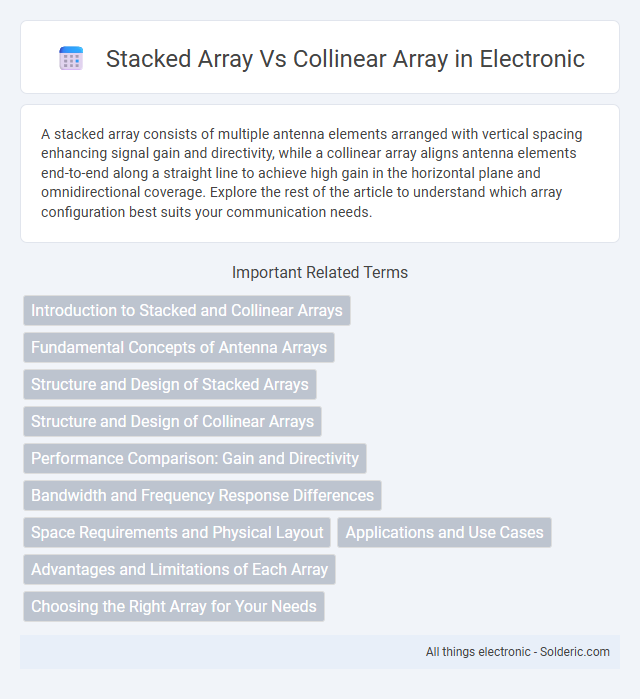A stacked array consists of multiple antenna elements arranged with vertical spacing enhancing signal gain and directivity, while a collinear array aligns antenna elements end-to-end along a straight line to achieve high gain in the horizontal plane and omnidirectional coverage. Explore the rest of the article to understand which array configuration best suits your communication needs.
Comparison Table
| Feature | Stacked Array | Collinear Array |
|---|---|---|
| Definition | Multiple antenna elements placed one above another vertically. | Antenna elements arranged along a single straight horizontal line. |
| Radiation Pattern | Narrower vertical beamwidth, increased gain in elevation. | Narrower horizontal beamwidth, directional azimuth coverage. |
| Gain | Higher vertical gain due to vertical stacking. | Higher horizontal gain focusing energy along the line. |
| Application | Used to enhance vertical coverage like broadcast towers. | Used in point-to-point links requiring horizontal directivity. |
| Physical Size | Taller structures, requires vertical space. | Longer horizontal footprint, requires lateral space. |
| Beam Steering | Vertical beam shaping achievable. | Horizontal beam steering more straightforward. |
| Complexity | Moderate assembly complexity with vertical stacking. | Simple linear assembly but may require phase control. |
Introduction to Stacked and Collinear Arrays
Stacked arrays consist of multiple antenna elements arranged vertically with precise spacing to achieve increased gain and directivity, commonly used in applications requiring higher power output. Collinear arrays feature antenna elements aligned end-to-end along a common axis, producing a narrow vertical beamwidth ideal for ground-plane coverage and enhanced signal strength. Both array types optimize radiation patterns to suit specific communication needs, balancing gain, beamwidth, and spatial configuration.
Fundamental Concepts of Antenna Arrays
Stacked arrays consist of multiple antenna elements arranged in parallel planes to increase gain and directivity by reinforcing radiation patterns vertically. Collinear arrays align identical antenna elements end-to-end along a single axis, enhancing horizontal gain and producing a narrow azimuth beamwidth. Both configurations manipulate element spacing and phase relationships to optimize radiation patterns for specific communication requirements.
Structure and Design of Stacked Arrays
Stacked arrays feature multiple antenna elements placed vertically one above another, enhancing gain and directivity by combining their radiation patterns, which is ideal for long-range communication. Their design requires careful spacing, typically half-wavelength apart, to minimize mutual coupling and achieve constructive interference. Your choice between stacked and collinear arrays depends on desired beamwidth and installation constraints, with stacked arrays offering more control over vertical beam shaping.
Structure and Design of Collinear Arrays
Collinear arrays feature multiple antenna elements arranged in a single straight line, optimizing vertical beamwidth and enhancing gain by constructive interference along the main radiation axis. Their linear structure allows for increased directivity and improved signal strength in communication systems, making them ideal for applications requiring narrow elevation patterns. Unlike stacked arrays that use vertically separated multiple arrays, collinear arrays rely on phase-coherent elements to achieve uniform radiation patterns and reduced side lobes.
Performance Comparison: Gain and Directivity
Stacked arrays generally offer higher gain by increasing effective aperture through multiple elements spaced vertically, enhancing directivity mainly along the elevation plane. Collinear arrays improve directivity by aligning elements end-to-end in a vertical line, producing a narrow vertical beamwidth and increased gain without as much vertical stacking height. Both arrays boost antenna performance, but stacked arrays tend to deliver superior gain, while collinear arrays excel in maintaining a more uniform horizontal radiation pattern.
Bandwidth and Frequency Response Differences
Stacked arrays typically offer wider bandwidth and more stable frequency response compared to collinear arrays due to their layered element arrangement, which reduces mutual coupling and enhances impedance matching. Collinear arrays, while providing higher gain in specific frequency bands, often exhibit narrower bandwidth and more pronounced variations in frequency response. Understanding these differences helps you select the optimal antenna configuration based on desired frequency coverage and signal consistency.
Space Requirements and Physical Layout
Stacked arrays require more vertical space due to their layered design, allowing multiple antenna elements to be placed one above another, which increases overall height but reduces horizontal footprint. Collinear arrays align antenna elements vertically in a single linear arrangement, minimizing ground space but often demanding precise spacing to avoid interference and maintain performance. The stacked array's compact horizontal layout suits horizontal space constraints, whereas the collinear array is ideal for narrow, vertical installations with limited ground area.
Applications and Use Cases
Stacked arrays are ideal for applications requiring increased gain and directivity, such as radar systems and long-range communication, because they combine multiple antenna elements vertically to boost signal strength. Collinear arrays excel in applications demanding omnidirectional coverage and uniform horizontal radiation patterns, making them perfect for broadcast antennas, cellular base stations, and Wi-Fi networks. Your choice depends on whether you prioritize directional gain or broad area coverage for efficient wireless communication.
Advantages and Limitations of Each Array
Stacked arrays offer improved beamforming capabilities and higher gain by vertically stacking multiple radiating elements, making them ideal for applications requiring narrow beamwidth and enhanced directivity. Limitations of stacked arrays include increased size and complexity, as well as potential mutual coupling effects that can degrade performance. Collinear arrays provide a simpler, more compact design with broadside radiation patterns and moderate gain, but they suffer from lower directivity and less control over beam shaping compared to stacked arrays.
Choosing the Right Array for Your Needs
Stacked arrays offer higher gain and directivity by vertically combining multiple antennas, making them ideal for long-range communication and overcoming obstacles. Collinear arrays focus on broad horizontal coverage with a consistent radiation pattern, perfect for urban or mobile applications requiring wide-area signal distribution. Your choice depends on whether you prioritize signal range and strength (stacked arrays) or uniform coverage and space efficiency (collinear arrays).
stacked array vs collinear array Infographic

 solderic.com
solderic.com